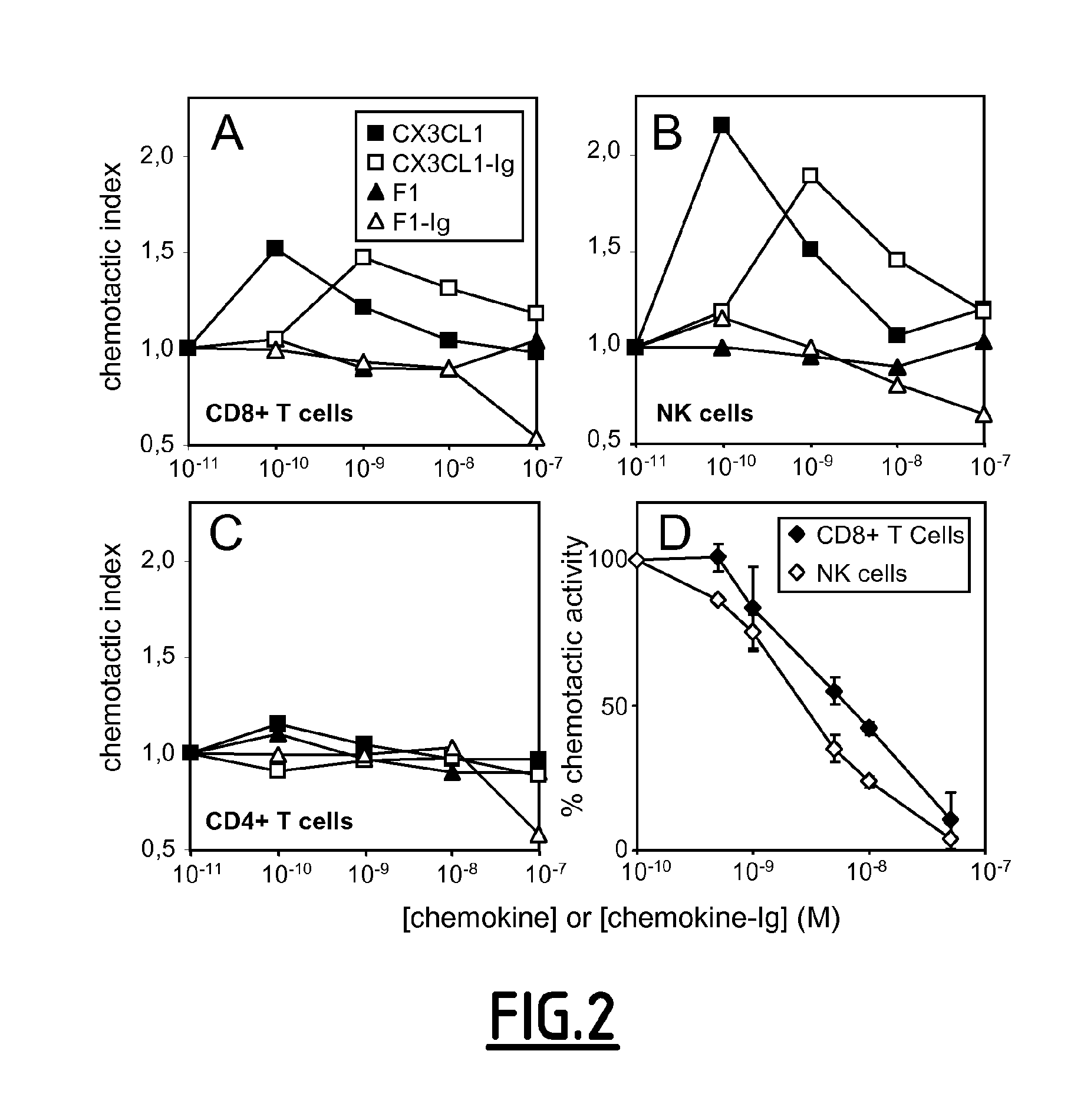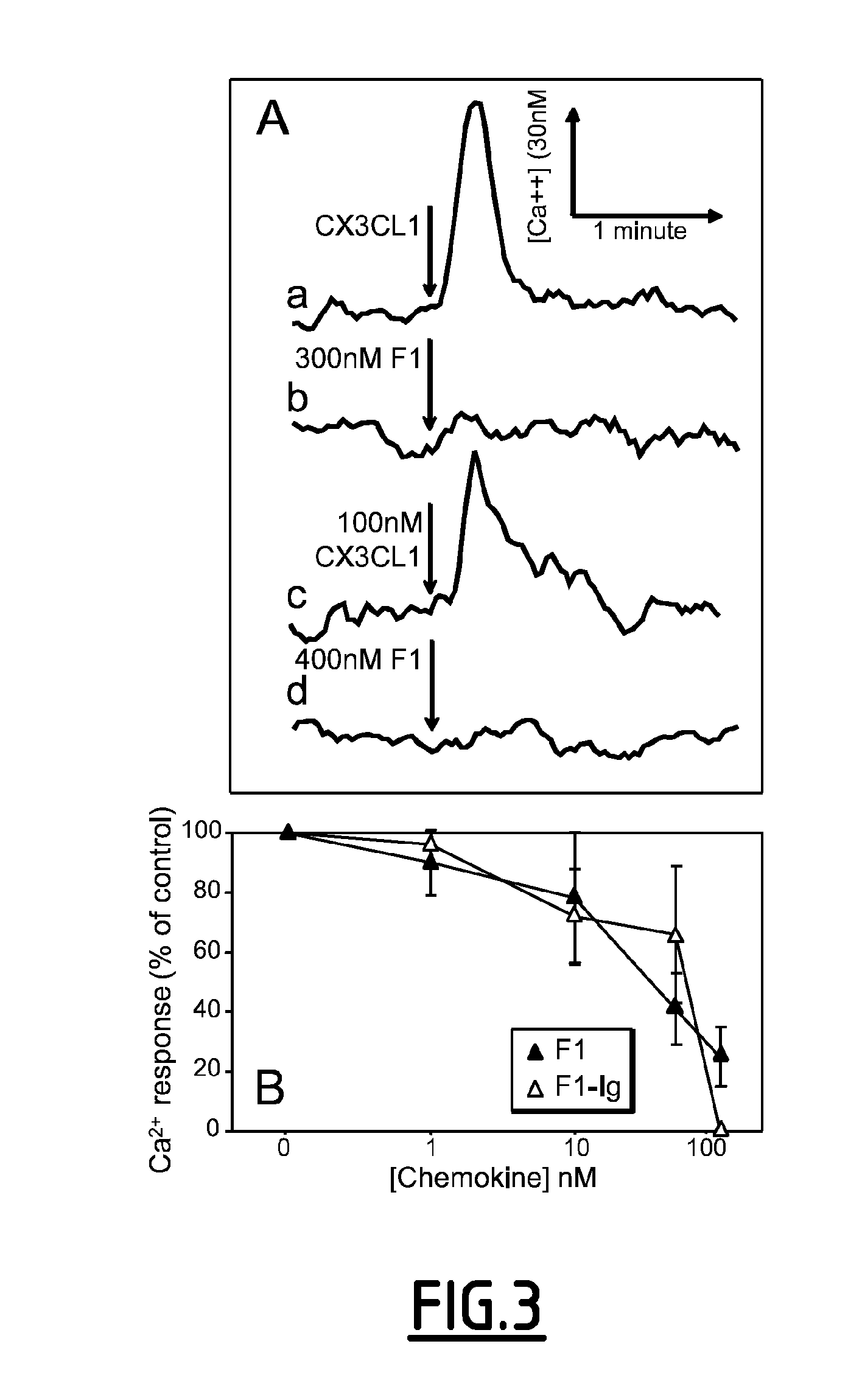Modulators of the cx3cri receptor and therapeutic uses thereof
a technology of cx3cr1 and receptor, which is applied in the direction of antibody medical ingredients, peptide/protein ingredients, depsipeptides, etc., can solve the problems of low apparent binding affinity of cx3cr1 and/or cx3cl1, poor apparent binding affinity of proteins, and low cx3cr1 and/or cx3cl1
- Summary
- Abstract
- Description
- Claims
- Application Information
AI Technical Summary
Benefits of technology
Problems solved by technology
Method used
Image
Examples
example 1
Protocols
[0192]1.1. Cell Lines
[0193]Human monocytic leukemia (THP-1), human embryonic kidney (HEK) and Chinese hamster ovary (CHO and CHO-S) cell lines were routinely maintained in DMEM supplemented with 2 mM L-glutamine, 1% (v / v) nonessential amino acids, 2 mM sodium pyruvate, 10% FBS, penicillin (50 U / mL) and streptomycin (50 μg / mL). HEK-CCR5 and HEK-CX3CR1 cells have been described by Combadiere et al. (1996, J. Leukoc. Biol. 60, 147-152) and Combadiere et al. (1998, J. Biol. Chem. 273, 23799-23804). The CHO cells expressing human CX3CR1 were a gift from Dr. Jeffrey K. Harrison (Department of Pharmacology and Therapeutics, College of Medicine, University of Florida, Gainesville, Fla., USA). Human peripheral blood mononuclear cells (PBMC), obtained from healthy donors, and mouse mononuclear bone marrow cells (MBMC) from C57BL / 6 mice were purified with Ficoll-Hypaque gradient centrifugation.
[0194]1.2. Phage-Chemokine and Libraries Constructions
[0195]The DNA sequence coding for huma...
example 2
Engineering the CX3CR1 Modulators
[0220]2.1. Engineering the CX3CR1 Antagonists
[0221]Phage particles can be efficiently endocytosed by mammalian cells in a receptor-dependent manner, and phage-chemokine agonists can be recovered after cell lysis. A modified phage display-based selection strategy with live-cell competitive elution was used to select preferentially for CX3CL1 variants with antagonist properties. In this strategy, the phage library was incubated with CX3CR1-expressing cells at 37° C. to allow ligand-induced internalization of agonist phage particles. Phage displaying CX3CR1 antagonists would not enter the cell and would therefore be susceptible to competitive elution with a large excess of soluble CX3CL1.
[0222]The human CX3CL1 chemokine domain, which consists of the first 77 residues of the mature protein, was cloned for expression by phage display. CX3CL1-phage showed detectable binding on anti-CX3CL1 antibody but not isotype control antibody. Additionally, CX3CL1-phag...
example 3
Characterization of F1 as CX3CR1 Ligand
[0234]The binding affinity of F1 for CX3CR1 was compared to that of native
[0235]CX3CL1 in a competition binding, with HEK-CX3CR1 cells and [125I]-CX3CL1 as a tracer. The F1 analogue interacted with CX3CR1, although with a lower affinity than CX3CL1. An apparent binding affinity (IC50) of 1.9 nM (Log IC50=−8.73±0.21; n=3) was determined for F1, which is approximately 12 times weaker than that of CX3CL1 (IC50=0.16 nM; Log IC50=−9.79±0.28; n=3). A similar difference in affinity was apparent when F1 and CX3CL1 were tested on CHO-CX3CR1 cells, and when the affinity of CX3CL1-Ig was compared to that of F1-Ig. Together, these data confirm that the F1 analogue binds specifically to CX3CR1, albeit with a slightly weaker affinity than native CX3CL1.
[0236]The phage selection strategy for antagonists was devised to preferentially select clones that are not internalized into CX3CR1-expressing cells. It was confirmed that, unlike native CX3CL1, which induced...
PUM
| Property | Measurement | Unit |
|---|---|---|
| v/v | aaaaa | aaaaa |
| final volume | aaaaa | aaaaa |
| temperature | aaaaa | aaaaa |
Abstract
Description
Claims
Application Information
 Login to View More
Login to View More - R&D
- Intellectual Property
- Life Sciences
- Materials
- Tech Scout
- Unparalleled Data Quality
- Higher Quality Content
- 60% Fewer Hallucinations
Browse by: Latest US Patents, China's latest patents, Technical Efficacy Thesaurus, Application Domain, Technology Topic, Popular Technical Reports.
© 2025 PatSnap. All rights reserved.Legal|Privacy policy|Modern Slavery Act Transparency Statement|Sitemap|About US| Contact US: help@patsnap.com



